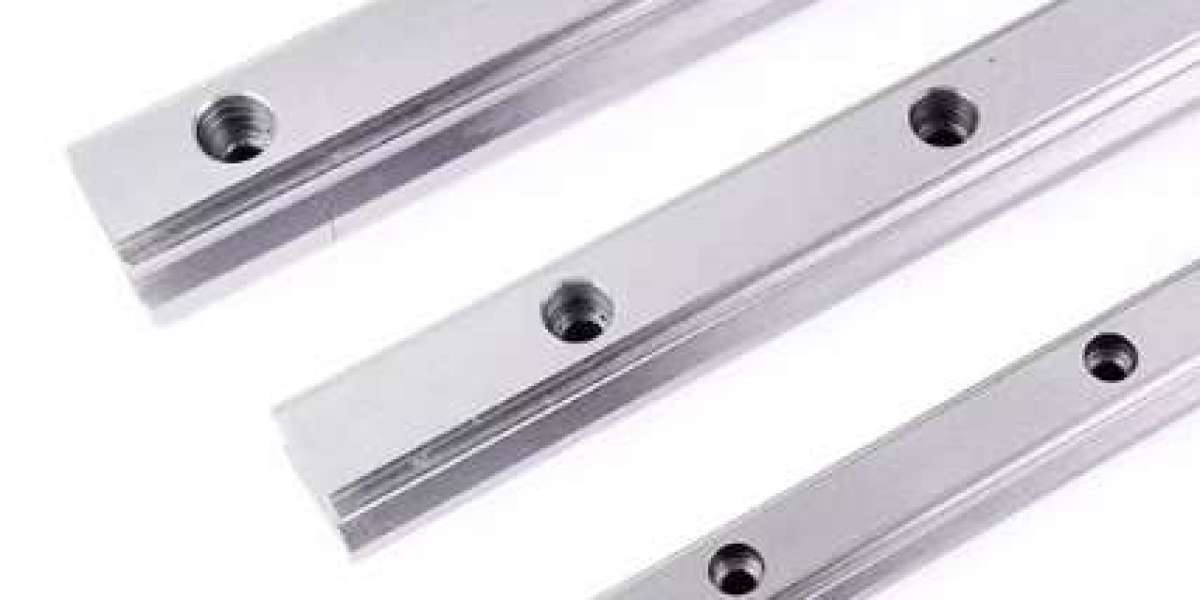What Are Linear Rails?
Linear rails, also known as linear guideways, are engineered components that enable smooth, precise linear motion. Unlike conventional rotational bearings, which are designed to facilitate circular movement, linear rails provide a guided path for loads to move linearly. Typically, a linear rail system consists of a rail and a carriage or slider equipped with rolling elements such as balls or rollers. This setup minimizes friction, reduces wear, and delivers superior accuracy.
The advantages of linear rails are significant when compared to traditional sliding systems. Sliding systems operate with direct surface contact, leading to higher friction, wear, and energy consumption. Linear rails, with their rolling elements, allow smooth movement with minimal friction. This not only extends the lifespan of machinery components but also reduces energy consumption, noise, and maintenance requirements, all of which contribute to more efficient industrial operations.
The Impact of Linear Rails on CNC Machines
CNC (Computer Numerical Control) machines require extreme precision for operations such as cutting, drilling, and milling. Any deviation in motion can compromise product quality, waste materials, and increase production costs. Linear rails are critical in maintaining tight tolerances and ensuring the machine operates accurately and consistently.
In a CNC milling machine, for instance, linear rails guide the cutting head along the X, Y, and Z axes. The precise alignment and minimal vibration provided by high-quality linear rails ensure that each cut follows the programmed path exactly. This results in higher-quality parts, reduced material waste, and greater overall efficiency. Moreover, the smooth movement of linear rails allows for faster machine operation without sacrificing accuracy, enabling manufacturers to meet tighter production schedules.
At https://yhlinear.com/, our linear rails are crafted using high-precision materials and advanced manufacturing techniques to ensure consistent performance under demanding conditions. Whether it’s a large industrial CNC machine or a compact automated system, our rails provide the stability and accuracy needed for optimal results.
Benefits of Using High-Precision Linear Rails
1. Improved Accuracy and Repeatability
Linear rails provide exceptional positional accuracy, which is vital for applications where precision matters. This accuracy ensures that operations can be repeated with minimal deviation, reducing errors and improving product quality.
2. Higher Load Capacity
Quality linear rails can support heavy loads without compromising performance. This allows for more flexibility in designing machinery capable of handling multiple or heavier components efficiently.
3. Lower Maintenance Requirements
By reducing friction through rolling elements, linear rails minimize wear and extend the operational life of machines. This translates into reduced downtime, lower maintenance costs, and improved productivity.
4. Smooth and Quiet Motion
The low-friction design of linear rails ensures smoother motion and quieter operation, which is particularly beneficial in environments where noise reduction is important.
5. Energy Efficiency
Because less force is needed to move loads along linear rails, machines consume less energy, reducing operational costs and environmental impact.
Applications Beyond CNC Machinery
While CNC machines are a prominent application of linear rails, their use extends across a wide range of industries. In semiconductor manufacturing, linear rails guide robotic arms with micrometer-level precision, ensuring delicate components are handled safely. In the medical field, linear rails are used in imaging and diagnostic equipment to provide smooth, reliable motion. Automated assembly lines, packaging machines, and material handling systems also benefit from the precision, reliability, and load capacity of linear rails.
The versatility of linear rails is a testament to their robust design and engineering. They can operate in high-speed, high-load, and high-precision environments while maintaining consistent performance. This adaptability makes linear rails indispensable in modern industrial automation.
Choosing the Right Linear Rail System
Selecting the right linear rail involves considering factors such as load capacity, travel distance, speed, environmental conditions, and precision requirements. For example, heavy-duty applications like large CNC machines or automated assembly lines require rails with high rigidity and load capacity. Conversely, delicate applications such as medical devices or electronics manufacturing prioritize smooth, low-friction motion.
At https://yhlinear.com/, we provide expert guidance to help clients choose the most suitable linear rail system for their specific needs. Our engineers analyze the application requirements to recommend rails that optimize performance, reliability, and cost-efficiency.
Maintenance and Longevity
To maximize the lifespan of linear rails, regular maintenance is essential. This includes proper lubrication, alignment checks, and protecting the rails from contaminants. Advanced linear rails often feature integrated lubrication systems and protective seals, which reduce maintenance requirements and ensure consistent performance.
Our linear rails at https://yhlinear.com/ are designed for durability and low-maintenance operation. Features such as self-lubricating sliders and high-quality seals help minimize downtime and extend the operational life of the equipment.
Future Trends in Linear Motion Technology
The future of linear motion technology is focused on higher precision, faster speeds, and smarter monitoring. Integration with IoT-enabled sensors and predictive maintenance systems will allow machines to self-monitor rail conditions and alert operators before issues arise. Advances in materials, surface coatings, and lubrication systems will further enhance durability, load capacity, and energy efficiency.
Manufacturers who adopt these advancements will gain a competitive edge, achieving greater productivity, lower operational costs, and higher product quality. Linear rails will continue to play a central role in shaping the next generation of industrial automation.
Conclusion
Linear rails have become a cornerstone of modern industrial automation. Their ability to provide smooth, precise, and reliable motion has transformed CNC machining, robotics, semiconductor manufacturing, and medical equipment. By reducing friction, increasing load capacity, and improving accuracy, linear rails enhance operational efficiency and productivity across numerous industries.
At https://yhlinear.com/, we provide high-quality linear rails designed to meet the diverse needs of industrial automation. Our products ensure smooth, precise, and reliable motion for machinery of all types. Whether you are upgrading existing equipment or designing new systems, our linear rails deliver performance, longevity, and efficiency, helping your operations achieve optimal results.
Investing in premium linear rails is an investment in the future of your manufacturing operations. Explore the benefits of precision linear motion today and discover how https://yhlinear.com/ can provide the perfect solution for your industrial automation needs.








